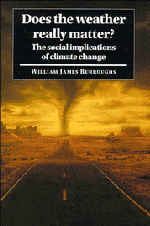3 - Cold winters
Published online by Cambridge University Press: 26 February 2010
Summary
‘Unimportant, of course, I meant,’ the King hastily said, and went on to himself in an undertone,
‘important – unimportant – unimportant – important –’ as if he were trying which word sounded best.
Alice's Adventures in Wonderland, Chapter 12
So far cold winters have only received passing mention. As the vulnerability of Europe to weather-induced subsistence crises declined with improved transport systems, increasing access to overseas food supplies and growing affluence, the impact of cold winters assumed greater importance. The response of many aspects of industrialised societies to the disruption caused by snow, ice and prolonged cold is non-linear. This is because the degree of disruption rises disproportionately as the temperature falls further below normal. The consequences of severe winters have been recognised in the underlying mortality statistics and in certain particularly poor harvests (e.g. 1709). Furthermore, the freezing of rivers and canals interrupted the production and distribution of food. In medieval England when there were up to 6000 water mills for grinding flour, the freezing rivers could stop the production of bread and so lead to severe shortages. But, by comparison with the disruption of more industrialised societies, these problems seem relatively minor.
There is also a statistical reason for considering the consequences of cold winters. This is that in mid-latitudes, especially in the northern hemisphere, the variability in winter weather is greater than in other seasons. Whether measured from year to year, from decade to decade, or as long-term trends, the biggest changes are seen in winter.
- Type
- Chapter
- Information
- Does the Weather Really Matter?The Social Implications of Climate Change, pp. 53 - 72Publisher: Cambridge University PressPrint publication year: 1997



